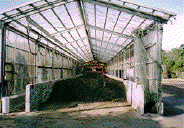 Science & Technology || Search|| Back Numbers WASTE NOT, WANT NOT: Boom in Recycling Plans for Organic Waste January 29, 1998 
More kitchen waste is headed for composting centers instead of the dump these days. (Photo: Huis Ten Bosch Co.) The movement to recycle kitchen garbage, which has hitherto mostly been incinerated, is accelerating. Having begun among restaurants and convenience stores, the movement has expanded to involve even agricultural organizations and local communities. The aim is to compost garbage for use in organic farming. Restaurants and convenience stores in particular are trying to set up their own recycling systems in order to make use of these organically grown vegetables to prepare dishes. Restaurants and Convenience Stores Of all businesses, eateries such as restaurant chains have started recycling garbage on the largest scale. One organization has taken the lead with a trial run that began in October 1997, in which kitchen waste and leftovers are taken to compost-making facilities. A total of 100 restaurants in 10 major chains in the Tokyo metropolitan area are taking part in this experiment. The compost is sold to a Tokyo-area agricultural producers group and used by farmers as organic fertilizer. The cycle will be completed when their organic produce is bought by the restaurant chains. And the food-service industry is set to cooperate financially with local governments and waste-disposal companies to construct compost-making plants in the near future. Industry projections indicate that over 1,000 restaurants in the metropolitan area will begin recycling by spring 1999. One leading convenience store chain also began recycling kitchen garbage at approximately 200 shops in Kanagawa Prefecture from September 1997. The contents of its unsold side dishes and boxed lunches are composted and used by subcontracted farmers as fertilizer. The agricultural produce is then used in making more side dishes and carry-out meals. Another convenience store chain also plans to start recycling organic
waste from its 600 Tokyo shops in fiscal 1998 (April 1998 to March 1999).
And the nation's biggest convenience store chain is investigating ways to
recycle not only waste from its own stores but also that produced by the
firms that make the meals and side dishes sold by the chain.
Movements to recycle kitchen garbage at local levels have also emerged.
In Higashimurayama City, a bedtown of Tokyo,investigation into whether it
is possible to compost household kitchen refuse at the municipal level has
been carried out since summer 1997. The 91 households in one city-managed
apartment are being monitored as they gather their kitchen refuse to be
processed by a compost-making machine on the apartment premises. The city
hopes to expand this recycling operation beginning in 1998 if all goes
well.
At one time most kitchen refuse was composted, but from the end of the Meiji era (1868-1912) waste incineration began in Tokyo, in consideration of the city's increased urbanization and of sanitation. Incineration became generalized after World War II due to the spread of chemical fertilizers and the concomitant decline in demand for compost, and the growth of cities throughout Japan. From 1996, however, Tokyo began charging a fee for the disposal of waste produced by businesses; the number of local governments also taking up this measure has increased. Moreover, it is predicted that a fee will be charged for the disposal of household garbage in the near future. For these reasons, businesses and households are becoming more aware of the importance of reducing the amount of rubbish they produce and of the benefits of recycling. Furthermore, as a result of the healthy-living boom, the demand for organically grown food has increased, leading to the rapid spread of moves to recycle organic waste as compost. Recently, simple compost-making machines designed for household use have appeared on the market, and the number of local government bodies subsidizing compost-making plants has also increased. Efforts to recycle kitchen garbage seem set to continue growing.  Edited by Japan Echo Inc. based on domestic
Japanese news sources. Articles presented here are offered for reference
purposes and do not necessarily represent the policy or views of the Japanese
Government. Edited by Japan Echo Inc. based on domestic
Japanese news sources. Articles presented here are offered for reference
purposes and do not necessarily represent the policy or views of the Japanese
Government.
|
